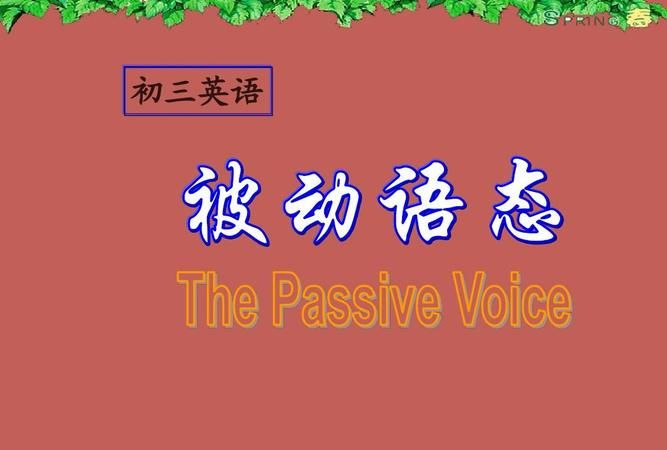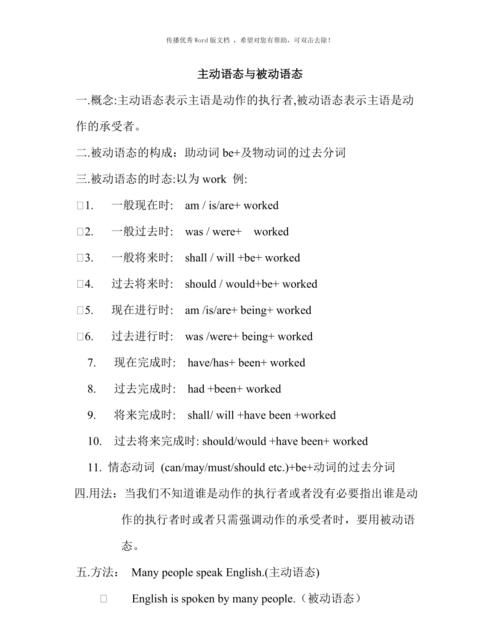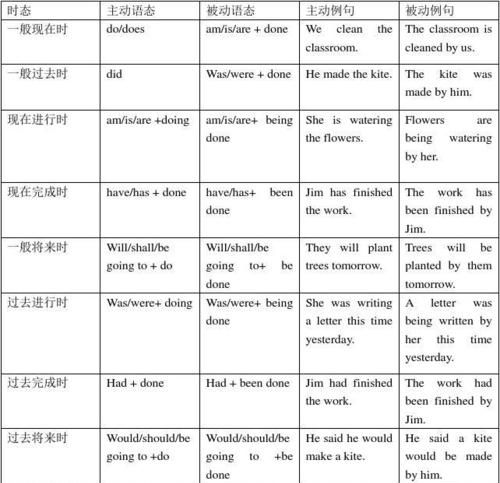本文目录
初中英语被动语态知识点总结
被动语态是动词的一种特殊形式,一般来说,只有需要动作对象的及物动词才有被动语态。下面我为大家分享初中英语被动语态知识,欢迎大家参考借鉴。
一、被动语态的构成形式
1. 被动语态的基本时态变化
被动语态通常为十种时态的被动形式, 被动语态由be+过去分词构成,be随时态的变化而变化。以do为例,各种时态的被动语态形式为:
1) am/is/are +done (过去分词) 一般现在时
例:Visitors are requested not to touch the exhibits.
2) has /have been done 现在完成时
例:All the preparations for the task have been completed, and we're ready to start.
3) am/is /are being done 现在进行时
例:A new cinema is being built here.
4) was/were done 一般过去时
例:I was given ten minutes to decide whether I should reject the offer.
5) had been done 过去完成时
例: By the end of last year, another new gymnasium had been completed in Beijing.
6) was/were being done 过去进行时
例:A meeting was being held when I was there.
7) shall/will be done 一般将来时
例:Hundreds of jobs will be lost if the factory closes.
8) should/would be done 过去将来时
例:The news would be sent to the soldier's mother as soon as it arrived.
9) shall/will have been done 将来完成时(少用)
例:The project will have been completed before July.
2. 被动语态的特殊结构形式
1)带情态动词的被动结构。其形式为:情态动词+be+过去分词。
例:The baby should be taken good care of by the baby-sitter.
2) 有些动词可以有两个宾语,在用于被动结构时,可以把主动结构中的一个宾语变为主语,另一宾语仍然保留在谓语后面。通常变为主语的是间接宾语。
例:His mother gave him a present for his birthday. 可改为 He was given a present by his mother for his birthday.
3) 当“动词+宾语+宾语补足语”结构变为被动语态时,将宾语变为被动结构中的主语,其余不动。
例:Someone caught the boy smoking a cigarette. 可改为The boy was caught smoking a cigarette.
4)在使役动词have, make, get以及感官动词see, watch, notice, hear, feel, observe等后面不定式作宾语补语时,在主动结构中不定式to要省略,但变为被动结构时,要加to。
例:Someone saw a stranger walk into the building. 可改为A stranger was seen to walk into the building.
5) 有些相当于及物动词的`动词词组,如“动词+介词”,“动词+副词”等,也可以用于被动结构,但要把它们看作一个整体,不能分开。其中的介词或副词也不能省略。
例The meeting is to be put off till Friday.
3. 非谓语动词的被动语态
v.+ing 形式及不定式 to do 也有被动语态(一般时态和完成时态) 。
例I don't like being laughed at in the public.
二、 如何使用被动语态
学习被动语态时,不仅要知道被动语态的各种语法结构,还要知道在哪些情况中使用被动语态。
1. 讲话者不知道动作的执行者或不必说出动作的执行者 (这时可省 by 短语)。
例: My bike was stolen last night.
2. 借助被动的动作突出动作的执行者。
例:I was given ten minutes to decide whether I should accept the offer.
3. 为了更好地安排句子。
例:The well-known person got on the bus and was immediately recognized by people. (一个主语就够了)
三、 It is said that+从句及其他类似句型
一些表示“据说”或“相信”的动词如believe, consider, expect, report, say, suppose, think等可以用于句型“It+be+过去分词+that从句”或“主语+be+过去分词+to do sth.”。
有:
It is said that… 据说,It is reported that…据报道,It is believed that…大家相信,It is hoped that…大家希望,It is well known that…众所周知,It is thought that…大家认为,It is suggested that…据建议。
例:It is said that the boy has passed the national exam. (=The boy is said to have passed the national exam. )
四、谓语动词的主动形式表示被动意义
1.英语中有很多动词如break,catch,clean,drive,lock,open,sell,read,write,wash等,当它们被用作不及物动词来描述主语特征时,常用其主动形式 表达被动意义,主语通常是物。
例: This kind of cloth washes well.
注意:主动语态表被动强调的是主语的特征,而被动语态则强调外界作用造成的影响。
试比较:The door won't lock. (指门本身有毛病)
The door won't be locked. (指不会有人来锁门, 指“门没有锁”是人的原因)
2.表示“发生、进行”的不及物动词和短语,如:happen, last, take place, break out, come out, come about, come true, run out, give out, turn out等以主动形式表示被动意义。
例: How do the newspapers come out? 这些报纸是如何引出来的呢?
3. 系动词没有被动形式, 但有些表示感受、感官的连系动词feel, sound, taste, book, feel等在主系表结构中常以主动形式表示被动意义。
例Your reason sounds reasonable
五、非谓语动词的主动形式表被动意义
在某些句型中可用动名词和不定式的主动形式表被动意义 。
1. 在need,want,require, bear等词的后面,动名词用主动形式表示被动意义,其含义相当于动词不定式的被动形式。
例:The house needs repairing(to be repaired).这房子需要修理。
2. 形容词worth后面跟动名词的主动形式表示被动含义,但不能跟动词不定式;而worthy后面跟动词不定式的被动形式。
例:The picture-book is well worth reading.(=The picture-book is very worthy to be read.)
3. 动词不定式在名词后面作定语,不定式和名词之间有动宾关系时,又和句中另一名词或代词构成主谓关系, 不定式的主动形式表示被动含义。
例: I have a lot of things to do this afternoon. (to do与things是动宾关系,与I是主谓关系。)
试比较:I’ll go to the post office. Do you have a letter to be posted? ( 此处用不定式的被动语态作定语表明you不是post动作的执行者。)
4.在某些“形容词+不定式”做表语或宾语补足语的结构中,句子的主语或宾语又是动词不定式的逻辑宾语时,这时常用不定式的主动形式表达被动意义。
这些形容词有nice,easy,fit,hard,difficult,important,impossible,pleasant,interesting等。
例:This problem is difficult to work out .(可看作to work out省略了for me).
5. 在too… to…结构中,不定式前面可加逻辑主语,所以应用主动形式表示被动意义。
例:This book is too expensive (for me) to buy.
6. 在there be…句型中,当动词不定式修饰名词作定语时,不定式用主动式作定语,重点在人,用被动形式作定语,重点在物。
例:There is no time to lose(to be lost).(用 to lose可看成for us to lose;用to be lost,谁 lost time不明确。)
7. 在be to do结构中的一些不定式通常应用主动表主动,被动表被动。然而,由于古英语的影响,下列动词rent,blame,let等仍用不定式的主动形式表示被动意义。
例: Who is to blame for starting the fire?

初中常见的被动语态的结构
一般现在时,主动:1、am,is,are 2、动词用原形,单三要+s或es 被动:am,is,are+动词的过去分词(ved)
一般过去时,主:1、was,were 2、动词的过去式 被:was,were+ved
一般将来时,主:will,shall+动词原形 被:will,shall+be+ved
现在进行时,主:am,is,are+动词的现在分词 被:am,is,are+being+ved
过去进行时,主:was,were+动词的现在分词 被:was,were+being+ved
现在完成时,主:have,has+动词的过去分词 被:have,has+been+ved

中考英语被动语态知识点总结
初中英语语法总结之被动语态知识点
下文是对被动的概念、构成、用法等的介绍,如果对被动语态还不够了解的话,请详细阅读下文。

一、概述
英语中有两种语态,主动和被动。
例如:Many people speak English. 谓语:speak的动作是由主语many people来执行的。 被动语态表示主语是动作的`承受者,即行为动作的对象。例如:English is spoken by many people.主语English是动词speak的承受者。 所谓主动句就是由主动态动词(词组)作谓语动词的句子,而被动句则是由被动态动词(词组)作谓语动词的句子。 例如:He opened the door.他开了门。(主动句) The door was opened.门被开了。(被动句)
二、被动语态的构成
被动语态由“助动词be+及物动词的过去分词”构成。人称、数和时态的变化是通过be的变化表现出来的。现以teach为例说明被动语态在各种时态中的构成。
一般现在时:am/is/are+taught
一般过去时:was/were+taught
一般将来时:will/shall(be going to) be+taught
现在进行时:am/is/are being+taught
过去进行时:was/were being+taught
现在完成时:have/has been+taught
过去完成时:had been +taught
过去将来时:would(was/were going to) be+taught
;
以上就是关于初中阶段的被动语态 ,初中英语被动语态知识点总结的全部内容,以及初中阶段的被动语态 的相关内容,希望能够帮到您。
